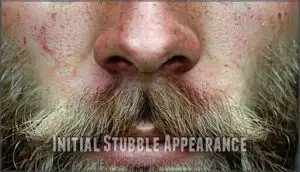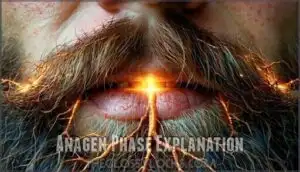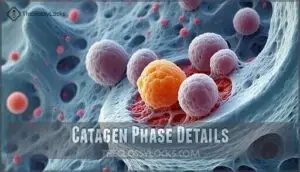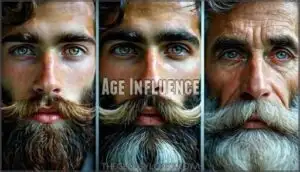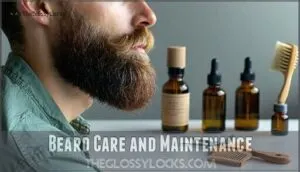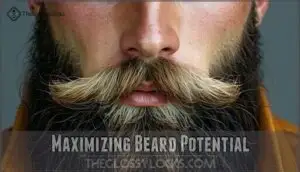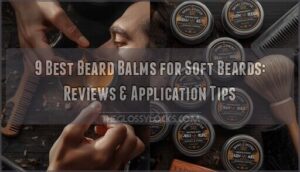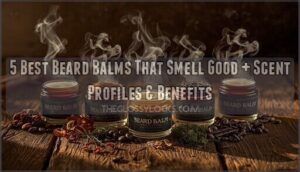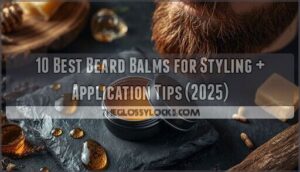This site is supported by our readers. We may earn a commission, at no cost to you, if you purchase through links.
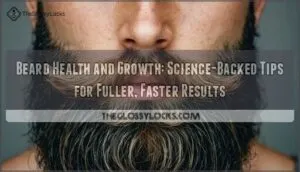
Your facial hair grows in cycles, with the active growth phase lasting 2-6 years. You can’t change your genetics, but you can fuel growth with the right nutrients.
B vitamins, biotin, zinc, and protein support healthy follicles. Omega-3 fatty acids reduce inflammation and promote circulation.
Most beards grow about half an inch monthly, though this varies by person. Quality beard oil keeps skin moisturized and prevents irritation.
Avoid over-washing and harsh products that strip natural oils. Patience matters most—rushing the process often backfires. The real game-changers lie in understanding your beard’s unique growth patterns.
Table Of Contents
Key Takeaways
- You can’t change your genetics, but you can optimize what you’ve got – Focus on proper nutrition with B vitamins, biotin, zinc, and protein while using quality beard oil to support your natural growth potential rather than fighting against your inherited blueprint.
- Your beard grows in predictable cycles that take time – The active growth phase lasts 2-6 years, with about half an inch of growth monthly, so you’ll need patience and realistic expectations rather than expecting instant results.
- What you eat directly impacts your beard’s health – Load up on omega-3 fatty acids, vitamin A, and protein sources like lean meats and eggs to fuel follicles and reduce inflammation that can slow growth.
- Consistent care beats aggressive tactics every time – Avoid over-washing and harsh products that strip natural oils; instead, stick to gentle cleansing twice weekly with specialized beard shampoo and regular trimming to prevent damage.
Beard Growth Phases
Your beard follows a predictable three-stage growth cycle that determines how fast and thick your facial hair grows.
Your beard’s destiny isn’t random—it follows a precise biological blueprint that you can learn to work with, not against.
Understanding these phases helps you set realistic expectations and work with your beard’s natural timeline rather than against it.
Initial Stubble Appearance
Within the first week of your beard growth journey, you’ll notice initial stubble emerging across your face.
This early facial hair often appears patchy and feels coarse, leading to stubble itch as follicles push through skin.
Don’t rush into trimming stubble yet—let it establish naturally. Focus on stubble softening with gentle cleansing while your beard growth stages begin.
Anagen Phase Explanation
The Anagen phase drives your beard’s growth engine for two to six years.
During this active period, hair follicle growth accelerates through robust blood supply delivering essential growth factors and nutrients.
Follicle activation transforms weak vellus hairs into thick terminal hairs.
This Anagen duration determines your beard’s maximum length potential, making nutrient delivery vital for ideal beard growth stages, which relies on the Anagen phase.
Catagen Phase Details
After your hair follicles finish their active growth period, they enter the Catagen phase.
This intermediate stage lasts about two to three weeks.
During this time, follicle detachment occurs as your hair strand separates from its blood supply.
The follicle undergoes regression in size, shrinking substantially, and Catagen signals mark the end of active beard growth before hair shedding begins, which is a critical phase in the hair growth cycle, involving regression in size.
Telogen Phase Information
Understanding the Telogen phase helps you manage beard growth expectations.
During this resting period, hair strands detach and shed, making room for new growth. The Telogen Duration and Shedding Frequency vary, but follicles recover and prepare for the next cycle.
A significant portion of follicles, about 10-15%, are in this phase at any given time.
Here’s what you should know:
- Telogen Duration: 2-4 months
- Shedding Frequency: Normal
- Follicle Recovery: Essential
- Phase Influence: Minimizing Shedding
Factors Affecting Growth
Your beard’s growth depends on several factors, including your age, genetics, hormones, and even your ethnicity.
Understanding how these elements work together can help you set realistic expectations and make informed choices for healthier, fuller facial hair.
Age Influence
Your beard growth journey starts with puberty onset, often kicking in during your teenage years.
Peak growth usually happens between ages 18 and 30, when testosterone is high.
Mature beards fill out in your 20s, but declining growth is normal as testosterone declines with age.
As you age, the anagen phase shortens, which can impact hair thickness.
The beard growth timeline varies, so patience really pays off.
Ethnicity Impact
You’ll notice beard growth and beard density can look very different across cultures.
Mediterranean Beards often appear thick and full, while Chinese Beards may be sparser due to genetic predisposition.
Ethnic density, genetics, and hormones all play roles.
Factors like hair follicle development are essential for hair growth and density.
Cultural styles also shape how beards are worn, making your beard’s journey as unique as your heritage and ethnicity.
Genetic Factors
Inherited Traits play a big role in beard growth genetics.
If your dad or grandpa sported a thick beard, you might’ve the same luck.
Parental Influence sets your Genetic Potential, shaping Follicle Sensitivity and how your facial hair grows.
Ethnicity Variance also matters—some backgrounds grow fuller beards than others.
Your hair follicles simply follow the blueprint you’re born with.
Hormonal Effects
Two main hormones, testosterone and DHT, drive your beard’s growth. When these beard hormones hit their stride, your facial hair flourishes.
But hormonal imbalance or weak androgen receptors can slow things down.
Here’s how hormones impact your beard:
- Testosterone Levels
- DHT Conversion
- Androgen Receptors
- Hormonal Imbalance
- Supplement Impact on hormones
Nutrition for Beard Health
What you eat plays a big role in how healthy and full your beard can become, since your hair needs the right nutrients to grow strong.
Focusing on vitamins, healthy fats, and enough protein helps support beard growth and keeps your facial hair looking its best.
Vitamin a Importance
If you want your beard to thrive, vitamin A is a must-have nutrient.
It supports sebum production, keeping your facial hair moisturized, and aids cell renewal for stronger growth.
Lacking vitamin A can lead to dry, brittle hair—clear deficiency symptoms.
Add foods like sweet potatoes, carrots, and spinach to your diet for the full Vitamin A benefits and better beard health.
B Vitamins Role
After focusing on vitamin A, let’s talk about B vitamins. They’re key for beard health, supporting biotin synthesis and cell proliferation.
Without enough B vitamins, you risk hair thinning and slow beard growth. Biotin, a top beard vitamin, helps keratin production, making your beard stronger.
Beard growth supplements often include B vitamins to fill common B-vitamin deficiencies. Regular intake supports essential protein production, which is crucial for beard health and overall keratin production.
Omega-3 Fatty Acids Benefits
Omega-3 benefits often go overlooked, but they’re essential for beard health and scalp health.
Omega3 fatty acids boost hair resilience and beard hydration, keeping facial hair from getting dry or brittle.
Adding fatty acids sources like walnuts or flaxseed to your beard growth diet, or using beard growth supplements, helps support consistent beard growth and keeps follicles functioning at their best.
Supplementation with omega-3s may lead to improved chair-rise performance, according to some studies.
Protein Requirements
Think of protein as the building blocks for your beard.
Protein intake fuels hair follicles, powering keratin synthesis, which gives your beard strength and structure.
For real growth support, load up on protein sources like lean meats, eggs, fish, and legumes.
A balanced beard growth diet packed with nutrients guarantees your beard health stays strong, thick, and resilient, providing real growth support.
Supplements for Growth
Supplements can help fill nutritional gaps that may slow your beard growth, especially if your diet isn’t perfect.
By choosing the right options, you support your body’s natural ability to grow a fuller, healthier beard.
Biotin Benefits
After covering nutrition, let’s look at biotin, a top pick among beard vitamins.
Biotin and keratin work hand in hand for stronger hair. Signs of biotin deficiency include brittle hair or slow beard growth.
Most beard growth supplements include biotin, but check the biotin dosage guide. Eggs, nuts, and avocados are good biotin food sources.
Many users find a biotin supplement guide helpful for selecting the right product. Watch for rare biotin side effects.
Zinc Importance
After biotin, zinc steps up as a powerhouse for beard health.
Without enough zinc, you might see slow beard growth or patchy spots—classic signs of Zinc Deficiency.
Focus on Zinc Benefits by getting the right Zinc Dosage from Zinc Sources like meat, nuts, and seeds.
Many look to zinc supplements effects to boost facial hair.
Good zinc absorption helps your body use beard growth nutrients and beard growth supplements effectively.
Minoxidil Effects
After considering zinc’s role in beard health, let’s talk about minoxidil. This beard growth medication is often used off-label for fuller beards.
Stick to the right minoxidil dosage and proper application methods for best results. Watch for potential side-effects, especially with long-term use.
Many seek information regarding minoxidil beard products.
Expect these benefits:
- Thicker beard growth
- Noticeable results in 4 months
- Possible shedding phase
- Skin irritation risk
Multivitamin Role
While minoxidil can jumpstart beard growth, don’t overlook the power of a daily multivitamin.
Multivitamins fill gaps in your diet, tackling nutrient deficiencies that slow keratin production and hormone synthesis.
The right blend of beard vitamins supports follicle activation and overall health.
If you’re chasing a fuller beard, a quality multivitamin keeps your nutrient tank topped off.
Beard Growth Speed
You might wonder how fast your beard can actually grow, and what affects that speed.
Understanding average growth rates and the main factors at play helps you set realistic expectations and make the most of your beard journey.
Average Growth Rate
Tracking your beard growth rate helps set realistic Growth Expectations. On average, facial hair grows about half an inch per month—think of it as steady Monthly Increments.
Individual Variation is common, with genetics and hormones playing a big part in beard growth thickness. Using consistent Measurement Techniques, like weekly photos or digital calipers, gives you a clear picture of your progress.
Environmental Factors matter too.
Factors Determining Speed
Momentum in beard growth comes down to a mix of science and luck.
Your beard growth rate is shaped by these five main factors:
- Genetic Predisposition—your family tree sets the baseline.
- Hormonal Influence—testosterone and DHT drive growth.
- Nutrient Absorption—your body’s fuel.
- Blood Circulation—feeds follicles.
- Receptor Sensitivity—how well follicles respond to hormones.
These factors work together to influence the rate and fullness of your beard growth, making every individual’s experience unique.
Tips for Faster Growth
Progress thrives on routine. For faster beard growth, focus on stimulating follicles with gentle massage, exfoliation benefits, and boosting blood flow.
Prioritize sleep impact and stress reduction, as both affect hormone levels. Beard growth tips: use beard growth products, beard growth supplements, and beard growth vitamins.
Here’s a quick guide:
| Technique | Benefit | Example |
|---|---|---|
| Exfoliation | Unclogs pores | Beard scrub |
| Massage | Boosts blood flow | Circular motions daily |
| Sleep | Hormone balance | 7-8 hours nightly |
| Stress Reduction | Lowers cortisol | Meditation, exercise |
| Supplements | Nutrient support | Biotin, zinc, omega-3 |
For effective beard growth, consider the importance of beard growth products, beard growth supplements, and beard growth vitamins, as they provide essential nutrients for healthy growth.
Healthy Beard Development
Your beard’s health depends on avoiding harmful habits and creating the right conditions for growth.
You’ll achieve better results by protecting your facial hair from damage while supporting the natural growth process through proper care and nutrition.
Avoiding Harmful Factors
Your beard faces daily threats that can sabotage growth.
Smoking cessation improves blood flow to follicles, while stress reduction prevents cortisol from blocking testosterone.
Avoid product chemicals in harsh soaps and alcohol-based grooming items that strip natural oils.
Poor diet and sleep deprivation directly impact beard health.
These factors cause more beard damage than you realize.
Daily application of beard oil can combat beard dryness.
Promoting Healthy Growth
Your body responds best when you create the right conditions for beard growth.
Quality sleep triggers hormone production, while regular exercise boosts circulation to hair follicles. Managing stress levels prevents growth-stunting cortisol spikes that sabotage your progress.
- Sleep 7-9 hours nightly – Growth hormones peak during deep sleep cycles
- Exercise regularly – Cardio and strength training improve blood flow to follicles
- Practice stress reduction – Meditation, yoga, or hobbies lower cortisol levels
- Eat beard growth foods – Protein, vitamins, and healthy fats fuel follicle activity
Maintaining Beard Health
Consistent beard care prevents dandruff and provides itch relief through proper cleaning frequency.
You’ll want specialized beard shampoo twice weekly, not daily washing that strips natural oils.
Smart product selection includes quality oils and balms for styling techniques that maintain moisture.
Regular grooming habits create the foundation for long-term beard health and appearance.
Beard Care and Maintenance
Once you’ve established healthy beard growth, proper care and maintenance become essential for keeping your facial hair strong and well-groomed.
Regular use of beard oils, serums, and trimming techniques will help you maintain ideal beard health and appearance.
Beard Oil Benefits
Three drops of quality beard oil transform your grooming routine completely.
Hydration benefits include softer whiskers and reduced itching, while dandruff control keeps flakes away.
Application techniques matter—warm oil between palms, then massage into skin underneath.
This promotes skin health and beard growth simultaneously.
Choose scent profiles that match your style, making beard care an enjoyable daily ritual.
Beard Serum Differences
Unlike beard oil’s moisturizing focus, beard growth serums pack powerful serum ingredients like minoxidil and peptides that target follicles directly.
These beard growth products require precise application techniques—typically twice daily on clean skin.
While beard oil softens existing hair, serums boost hydration levels deeper, promoting actual beard growth. You’ll notice improved hair softness and dandruff reduction as bonus benefits alongside enhanced follicle stimulation.
Regular Trimming Importance
Trimming your beard regularly keeps it healthy and promotes better growth.
You’ll remove split ends that weaken hair strands and maintain your desired shape.
Regular cuts actually encourage fuller growth by preventing damage from spreading up the hair shaft.
- Shape Maintenance – Keep your beard’s outline clean and defined
- Split End Removal – Cut damaged tips before they cause more breakage
- Promoting Fullness – Remove weak hairs so stronger ones can thrive
- Encouraging Growth – Prevent damage that slows down healthy development
- Style Consistency – Maintain your chosen beard style with regular touch-ups
Maximizing Beard Potential
Your genetic makeup sets your beard’s basic growth pattern, but you can still work within those limits to achieve better results.
Smart lifestyle choices, proper nutrition, and consistent care routines help you reach your maximum beard potential, even if you can’t change your DNA, and by doing so, you can achieve a better beard.
Genetic Limitations
Everyone inherits their beard growth blueprint from family history, but you’re not stuck with weak genetics.
Your follicle sensitivity and growth potential stem from inherited patterns passed down through generations.
Ethnic variations play a major role in density and distribution.
While genetic predisposition sets your baseline, understanding these limitations helps you work within your natural capacity for ideal results to achieve the best possible outcome with your natural capacity.
Hormonal Optimization
Your hormones control beard growth more than you realize.
Testosterone and DHT levels directly impact facial hair density and thickness.
Optimizing these hormones can release your beard’s true potential through targeted approaches.
Here are five proven methods to optimize your beard hormones:
- Natural Testosterone Boosters – Zinc supplementation and resistance training increase your body’s testosterone production
- DHT Conversion Support – Foods rich in healthy fats help convert testosterone into DHT for thicker growth
- Receptor Sensitivity Enhancement – Minoxidil application improves how your follicles respond to hormones
- Hormone Balance Maintenance – Quality sleep and stress management keep your hormonal system functioning effectively
- Medical Interventions – Consult healthcare providers about hormone testing and potential treatments for deficiencies
Lifestyle Changes for Growth
Beyond hormonal balance, your daily choices substantially impact beard growth potential.
Quality sleep rebuilds hair follicles while regular exercise boosts circulation to facial areas.
Stress reduction prevents growth-inhibiting cortisol spikes, and proper hydration levels support nutrient delivery.
Smoking cessation improves blood flow dramatically.
These lifestyle strategies work synergistically with diet improvements to maximize your beard’s natural growth capacity and overall health.
Patience and Consistency
Your beard growth journey demands unwavering dedication and realistic expectations. Rome wasn’t built in a day, and neither is your beard. Long-term commitment beats quick fixes every time.
- Establish a consistent routine – Daily care creates steady progress over months
- Set realistic expectations – Full growth takes 2-4 months minimum
- Track your beard growth consistency – Photos help you see gradual changes
- Combat discouragement – Patchy phases are temporary and normal
- Celebrate small wins – Every week brings noticeable improvement with beard patience
Frequently Asked Questions (FAQs)
Can stress affect my beard growth rate?
Yes, chronic stress disrupts your hormone balance, particularly testosterone levels, which directly impacts facial hair development.
High cortisol from prolonged stress can slow growth and make your beard patchy or thin.
Why is my beard patchy and uneven?
Ever wonder why your facial hair looks like a checkerboard?
Genetics primarily controls where follicles grow, while testosterone levels, circulation patterns, and age determine density.
Some areas naturally develop slower than others, influenced by factors such as testosterone levels.
Does shaving make facial hair grow thicker?
Shaving doesn’t make your facial hair grow thicker or faster.
This common myth stems from blunt-cut hairs appearing coarser as they grow out.
Hair thickness is determined by genetics, not shaving frequency.
What causes beard dandruff and itching?
Dry skin underneath your beard creates those annoying white flakes and relentless itching. You’re dealing with seborrheic dermatitis, poor hygiene, or harsh products stripping natural oils from your skin.
How do I fix a scraggly beard?
Trim uneven lengths, brush daily with boar bristle brush, use beard oil to soften coarse hairs, and be patient.
Your scraggly beard needs consistent grooming and 2-3 months of growth to reach its full potential.
Conclusion
Statistics show men spend roughly 3,000 hours of their lifetime grooming facial hair, making proper care essential.
Your beard health and growth journey requires commitment to proven strategies rather than quick fixes.
Focus on balanced nutrition, quality products, and consistent routines while respecting your genetic blueprint.
Remember that sustainable results come from understanding your unique growth patterns and maintaining realistic expectations.
With patience and the right approach, you’ll maximize your beard’s natural potential and achieve the fuller results you’re seeking.
- https://thebeardclub.com/blogs/beard-culture/discover-beard-genetics
- https://gillette.com/en-us/shaving-tips/how-to-shave/beard-growth-science
- https://www.drdivyasharma.com/Mastering-the-Art-of-Beard-Care-and-Grooming/
- https://voltgrooming.com/why-men-should-grow-beards-beard-benefits-and-maintenance/
- https://nashvillehairdoctor.com/fue/hairline/debunking-common-beard-and-hair-growth-myths/

